While I consider myself a big-time fan of lemon desserts, this passionfruit curd beats lemon curd for me. Also known as passionfruit butter, it has the same amazing sweetness and tang as lemon curd but also a bright zing of the tropics that brings sunshine to anything.
- Sweet, tangy, creamy and buttery.
- Very quick and easy.
- Just 5 ingredients.
- No double boiler necessary.
- Make it from fresh, frozen or jarred pulp.
I make all my fruit curds directly in a saucepan (not in a double boiler). It’s quick, easy and works perfectly, so long as you keep the heat fairly low.
Try these passionfruit tartlets too!
This recipe was first published here on 8th January 2018 and has been updated with new information, a tweaked recipe and new images.
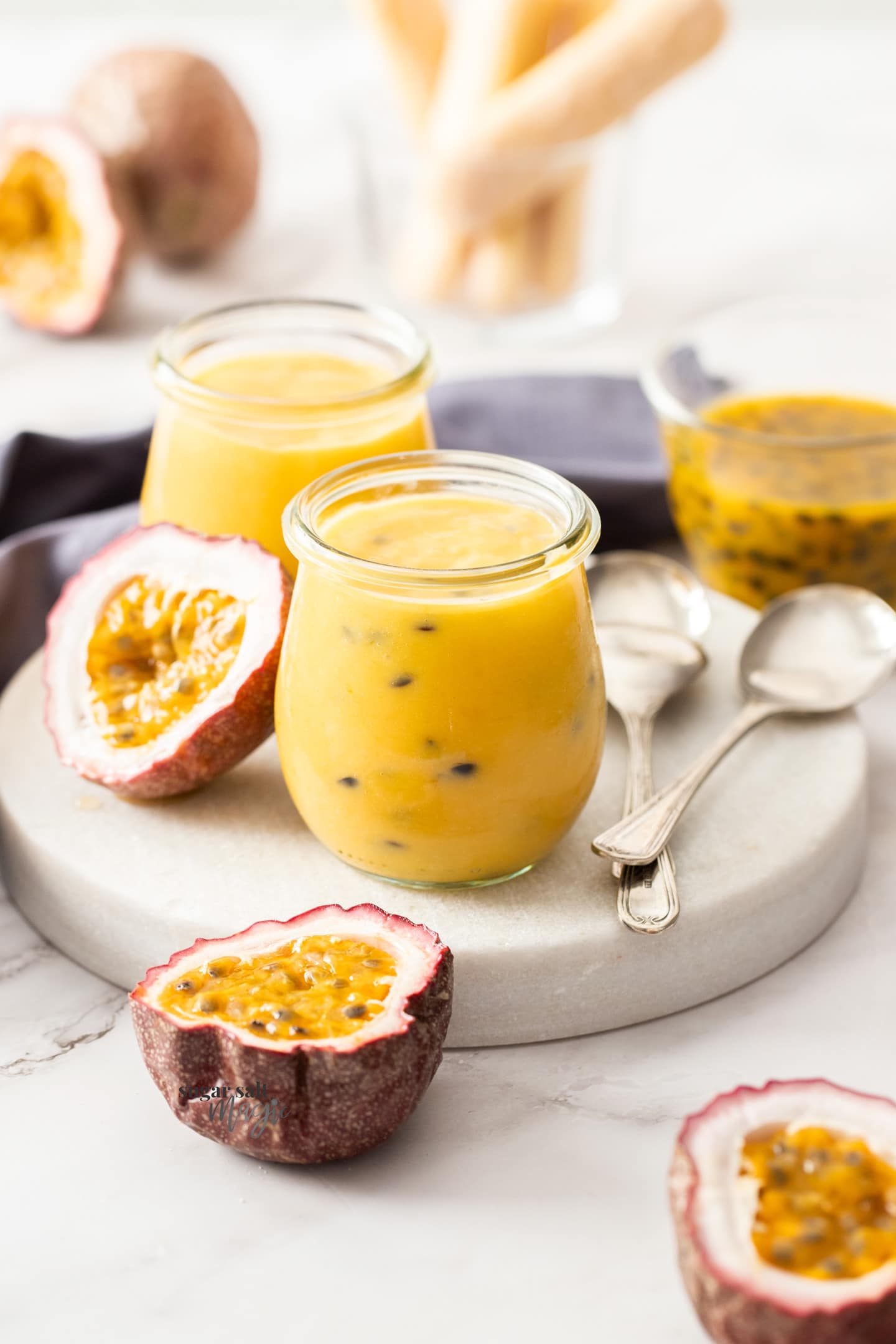
Table of contents
Never Miss a Recipe!
Get the latest recipes straight to your inbox!
Ingredients you’ll need
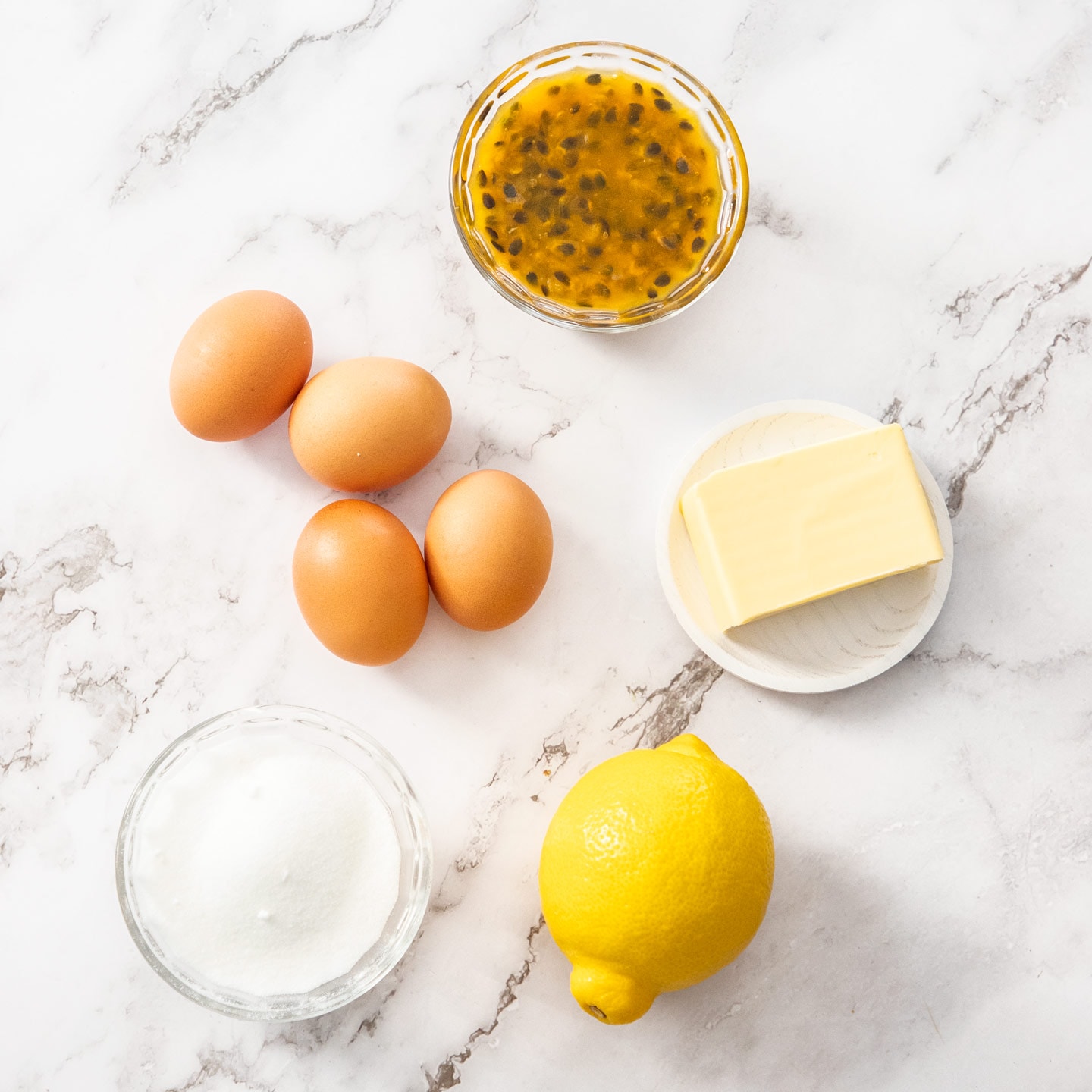
Detailed quantities and instructions in the recipe card below.
- Passionfruit pulp: You can use pulp from fresh passionfruits (you’ll likely need 5-6 passionfruits, depending on their size) but you can also use frozen (and thawed) passionfruit pulp or jarred passionfruit pulp too. Check the ingredients on the jar to make sure it’s nothing but passionfruit. I know the tinned pulp tends to have a lot of water and sugar added so doesn’t work so well. You may also see passionfruit pulp labelled as passionfruit puree.
- Eggs: I use large eggs in all my recipes. You’ll need 2 whole eggs and 2 egg yolks.
- Sugar: Use white granulated sugar or caster sugar (not powdered sugar).
- Lemon zest: Lemon zest adds a nice bit of tang to this recipe but you can skip it if you like.
- Butter: Use unsalted butter in this recipe.
What is a passion fruit?
Sunshine, my friends, sunshine. Passionfruit is a tropical fruit also known by the names lilikoi or maracuyá (and many more). There are two main types being yellow and purple. Here in Australia, they are available year round, although they are more well known as a summer fruit. Cutting open a passionfruit reveals the most beautiful centre of thick yellow juice (or pulp) and little black crunchy seeds. All the flavour is in the pulp, so feel free to strain out the seeds if you don’t like the texture.
How to make passionfruit curd (step-by-step)
Truly luscious, creamy and smooth (except for the seeds), passionfruit curd is incredibly easy to make. While many recipes will require you to use a double boiler (aka a bowl over a pan of simmering water resulting in indirect heat) this recipe keeps it super simple.
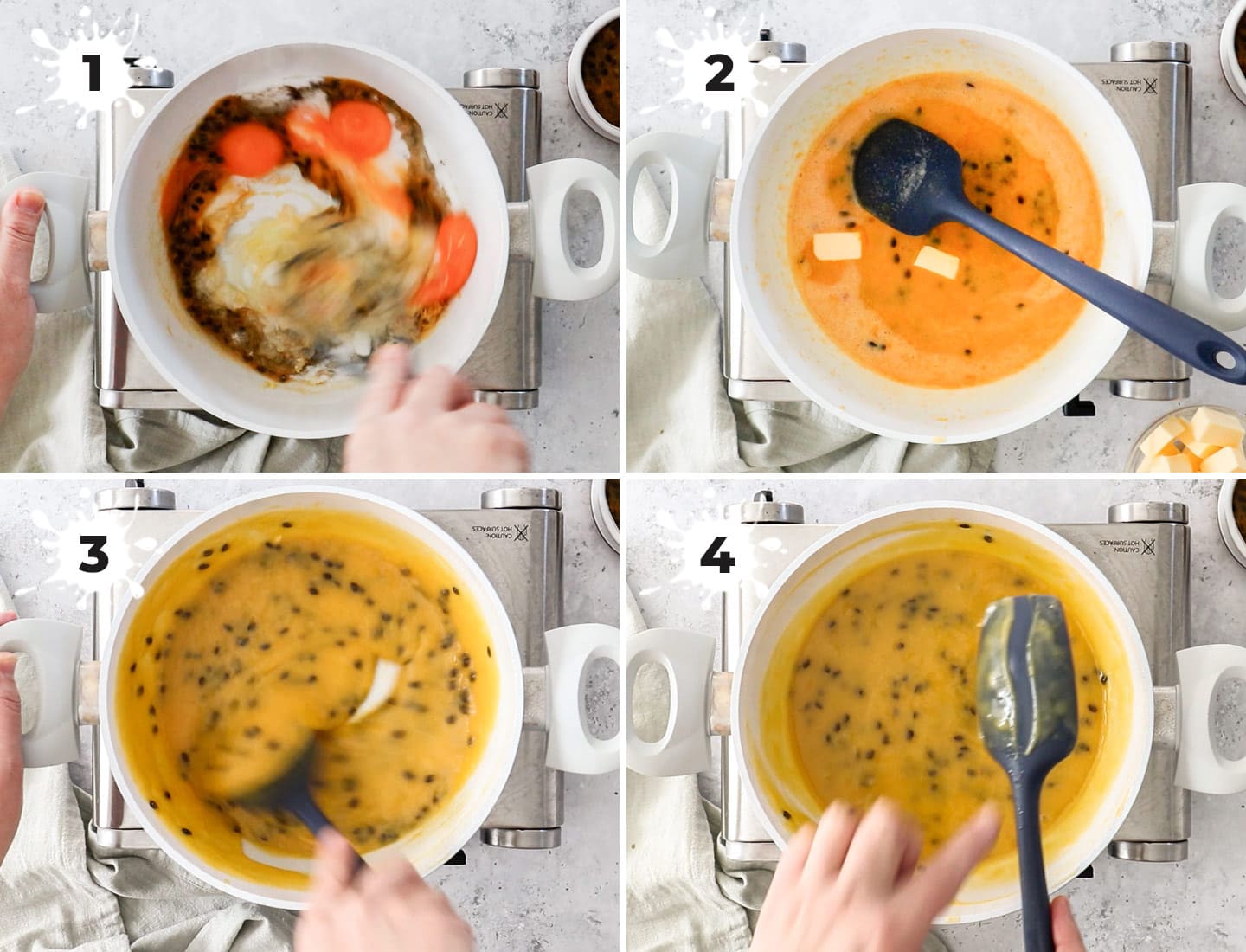
Detailed quantities and instructions in the recipe card below.
- Mix the first 4 ingredients: Start by whisking together passion fruit pulp, sugar, eggs and lemon zest. Heat them over low heat until the sugar dissolves (this only takes a minute or so).
- Add butter: With the heat on low-medium, add the butter 2-3 cubes at a time and stir constantly until it melts before adding more.
- Thicken it up: You may find that your curd is already finished by the time all the butter has melted in but if not, let it cook another minute or two until it’s thick enough to coat the back of a spoon.
- Straining is optional: If you don’t like the crunchy seeds, feel free to push your curd through a strainer to remove them. All the flavour is in the pulp anyway so it won’t change the flavour of your curd.
Handy tools to have
All you need to make this recipe is a small saucepan (non-reactive like stainless steel), a balloon whisk, silicone spatula and some preserving jars (I love these Weck preserving jars). You’ll also need a fine mesh sieve if you plan to strain it. Don’t use cast iron or aluminium cookware which will affect the taste of the curd.
Tips and tricks
- Use a heavy-based, non-reactive saucepan. This ensures the heat is distributed more evenly and the flavour of the curd will not be affected by the pan. Stick to stainless steel – no aluminium or cast-iron.
- Keep the heat low or low-medium: You want the heat fairly low as you don’t want this to come to a boil. Doing that will scramble the eggs so you’re after a slow, low heat to cook the egg without scrambling them.
- Stir constantly: You don’t want to leave the curd and must stay with it, stirring constantly. Don’t worry, it only takes around 10 minutes. The reason for this is to not only keep control over the temperature and not let the curd catch on the bottom of the pan but also, it’s helping to thicken and properly emulsify all the ingredients together.
- How to tell when it’s ready: The curd is ready once it coats the back of a spoon and you can draw a line through it with your finger, that won’t run when you hold it upright. You can also use a digital thermometer to check – it should reach 75C / 170F.
- Make sure to sterilise your jars: This will help the curd keep for longer.
- For notes on troubleshooting fruit curds, see my lemon curd post.
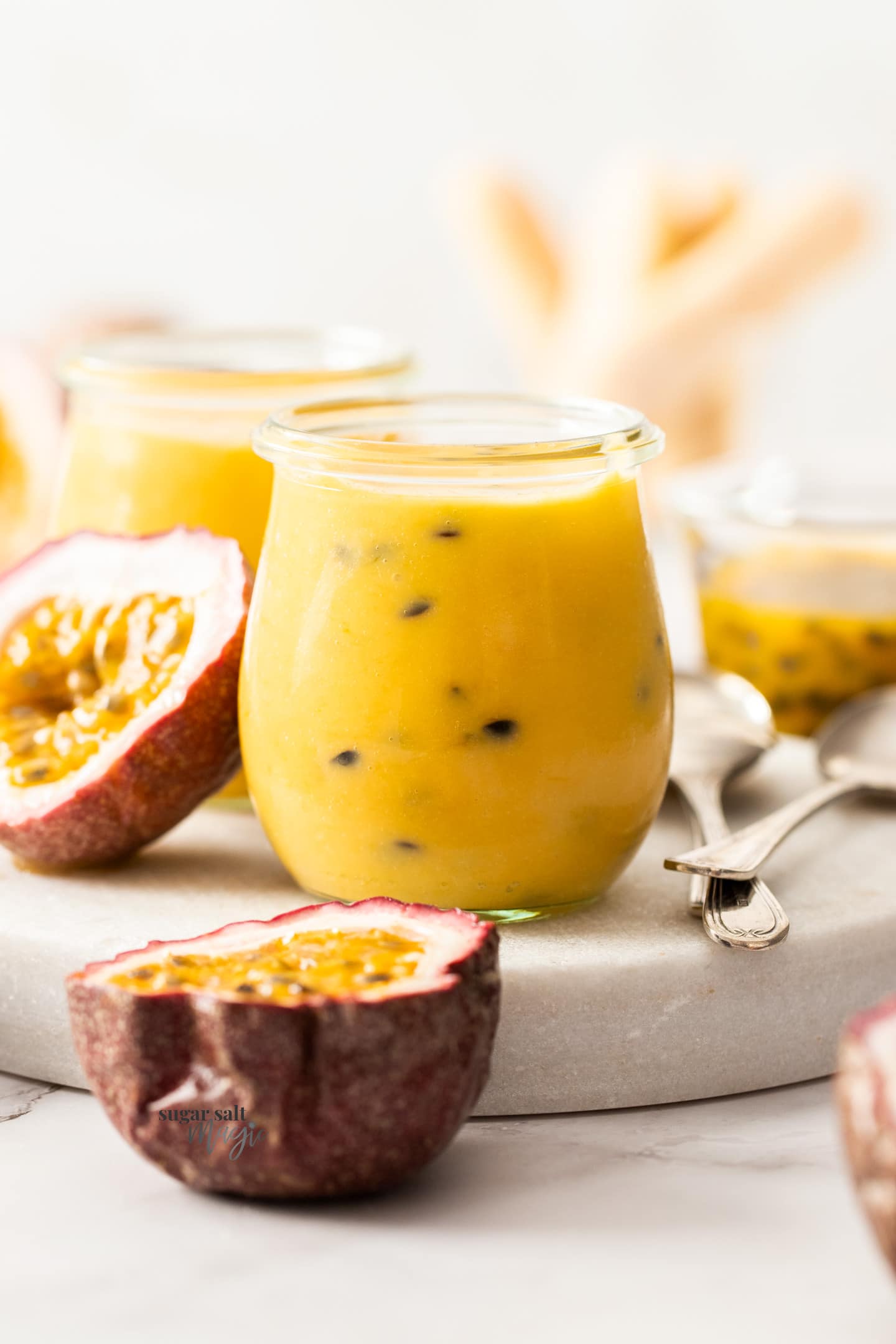
How to sterilise preserving jars
Sterilising the jars that you store any type of preserves in is very important if you want them to last longer than a week. This passionfruit curd will be fine in unsterilised jars for around a week but if you want it to last longer, either boil them in a saucepan of boiling water for 10 minutes then set aside to drain, dry and cool. The second way is to wash the jars well with soapy water, rinse and then place them in an oven at 120C / 250F for 10 minutes. Let them cool.
How to use curd
Fruit curds, like this passion fruit curd, are really versatile and a lovely decadent twist on many desserts. You could just stir it through yoghurt or spread it on toast but there’s so many more ways.
- Spread over scones or crumpets.
- Use them as a filling to Danish pastries.
- Fill or top cakes or cheesecakes
- A filling for cupcakes (like these passionfruit coconut cupcakes).
- Add it to crème patissiere for a flavoured pastry cream.
- Top pancakes or fill crepes.
- Use as a tart filling.
- Swirl it through ice cream.
- It’s wonderful for topping pavlovas.
- Or you could just dip biscuits / cookies in like I did here.
- Stir it through a cream cheese dip (I use 1 block of cream cheese to about 2-3 tablespoons of both sugar and milk, beat well, then swirl through some curd).
Yield and storage
This recipe will yield about 1 ½ cups of passionfruit curd.
The curd will keep in the fridge, in an airtight jar for up to a month, unopened. Once opened, use it within 7-10 days.
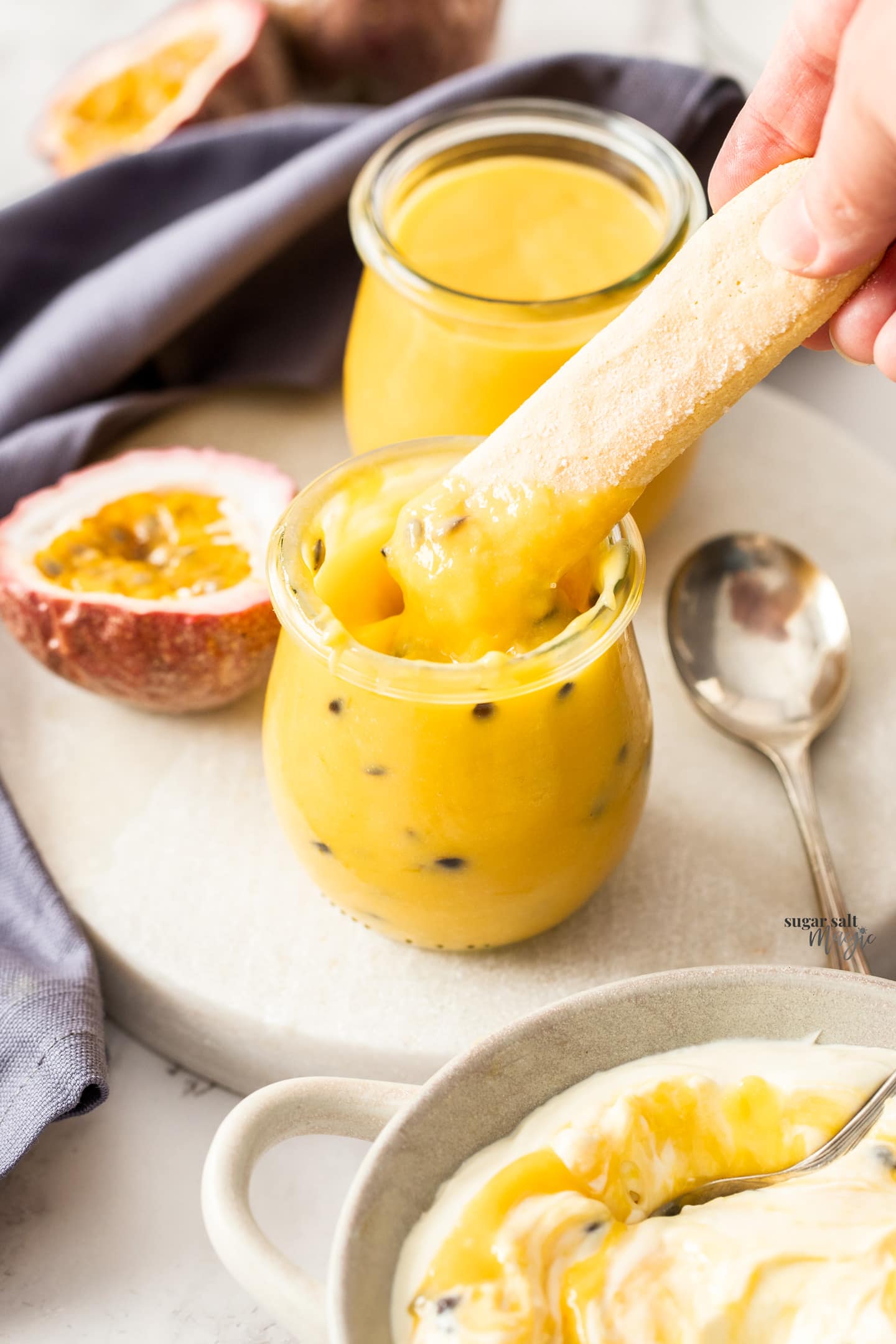
More fruit curd recipes
- Lime Curd
- Creamy Easy Pineapple Curd
- Easy Lemon Curd
- Homemade Blackberry Curd
- Homemade Mango Curd
- Blood Orange Curd
Did you try this passionfruit curd recipe?
Leaving a rating and comment below the recipe is so helpful!
Hungry for more? Subscribe to the newsletter for free recipes straight to your inbox. Also, follow along on Facebook, Pinterest and Instagram.
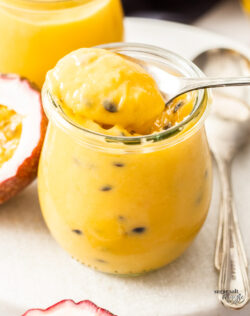
Ingredients
- ¾ cup caster (superfine) sugar (150g / 5.3oz)
- ⅔ cup passionfruit pulp
- 2 large eggs
- 2 egg yolks, from large eggs
- Zest of ½ a lemon
- 115 g unsalted butter, cubed and cold (½ cup / 1 stick / 4oz)
For best results, always weigh ingredients where a weight is provided
Instructions
- Whisk together the sugar, passionfruit pulp, eggs, egg yolks and zest in a small heavy-based, stainless steel saucepan.
- Stir over low-medium heat until the sugar has dissolved.
- Add the butter 2-3 pieces at a time, stirring until each addition is melted and incorporated.
- Turn the heat to low and continue cooking the mixture for 2-3 minutes until it is thickened and coats the back of a spoon or leaves a thick coating on the side of the pan when you tilt it. (Test by drawing a line through the curd on the back of the spoon and the line should not drip)
- If you like, strain the curd through a fine mesh sieve to remove any cooked eggy bits and the passionfruit seeds.
- Pour into sterilised preserve jars and store in the fridge.
- Please take a moment to leave a comment & rating. It's appreciated and so helpful.
Notes
- This curd will keep for up to 3 weeks in the fridge, unopened. Once opened use within a week. It will also freeze well.
- To sterilise the jars, boil them in a saucepan of boiling water for 10 minutes then set aside to drain, dry and cool. The second way is to wash the jars well with soapy water, rinse and then place them in an oven at 120C / 250F for 10 minutes. Let them cool.
- You can swap the butter for a vegetable based spread if you would like to make this curd dairy free.
This post may contain affiliate links that earn me a small commission for my referral, at no extra cost to you. Thank you for supporting Sugar Salt Magic.

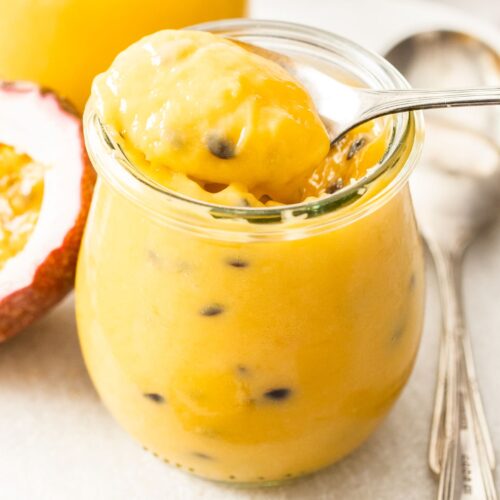


20 Comments on “Homemade Passionfruit Curd”
Looked at many passionfruit curd recipes and chose this one. Easy to combine and didn’t get all the eggy bits when cooked. Lovely rich passionfruit flaviur. Will save this recipe and make again.
I’m so happy to hear this, Janine. Thanks so much for dropping back to leave a review.
The best passionfruit curd I’ve ever eaten…and yes I ate it straight out of the saucepan!
So happy to hear this, Katie. Especially since I love it even more than lemon curd too.
Yummo
So happy you love it, Dianne.
I love but it is hard to make a comment because of the adds and other recipes that flick across. But thanks anyway. The sire us great
Thank you so much Shane. So happy you love it. I understand ads can be annoying but it’s the only way I can earn some money to keep creating free recipes. I appreciate you taking the time to leave a comment 🙂
Made this with frozen pulp and eating the warm curd with a spoon. It is soooo yummy! If there’s any left, I plan to make passionfruit buttercream.
So happy you love it Dee. It’s a little addictive 🙂
I used the frozen passionfruit cubes and then strained through sieve after cooking to take out black seeds. I then added a few to jars. Very easy recipe and very tasty
So happy you love it Cheryl
Anyone try making this sugar free? Using a sweetener? I’m diabetic so I have to cut out the sugar
Hi Jamie, I haven’t but I feel monk fruit sweetener would work a treat. Not sure about other varieties.
Making my second batch using dairy free margarine. Works perfectly. I also make it in the microwave, way easier and no continuous stirring needed. Also dosnt burn or stick to the bottom of the bowl.
Great news Nic, thanks for your tips 🙂
This passion fruit curd looks amazing. I love lemon curd too but now I gotta try this. I actually don’t see passion fruit a lot in the grocery store here, so I’m gonna have to go on a hunt!
We have it here frozen which I use if I can’t get it fresh so check the freezer section too ?
I just came across your recipe for passion fruit curd but I’ve used another one several times. Since fresh passion fruit is SO expensive I had to wait till I found it in another form. I found it in frozen cubes at Walmart and Target. When I say there’s nothing like the taste of passion fruit I mean it. It’s dangerously delicious lol. I made a 3 layer cake using the passion fruit curd as the filling. I even topped the top layer with the curd because why not, lol. I then decided to go away from my usual Pavlova lemon curd mixed into whipped cream by using the passion fruit curd on the top of the Pav shell then I added bananas then topped that with reg vanilla whipped cream. It was delicious. The only thing missing was MORE passion fruit curd lol. Next Pav I made it the same but this time I added a heavy drizzle of the curd all over it. I also added strawberries and raspberries on top. Yum. SO GOOD. Excited to see your recipe… 👍
It truly is so much better than lemon curd. I often use frozen passion fruit in my recipes or even jars but only use pure passionfruit pulp with no other added ingredients. That pav sounds truly amazing too!